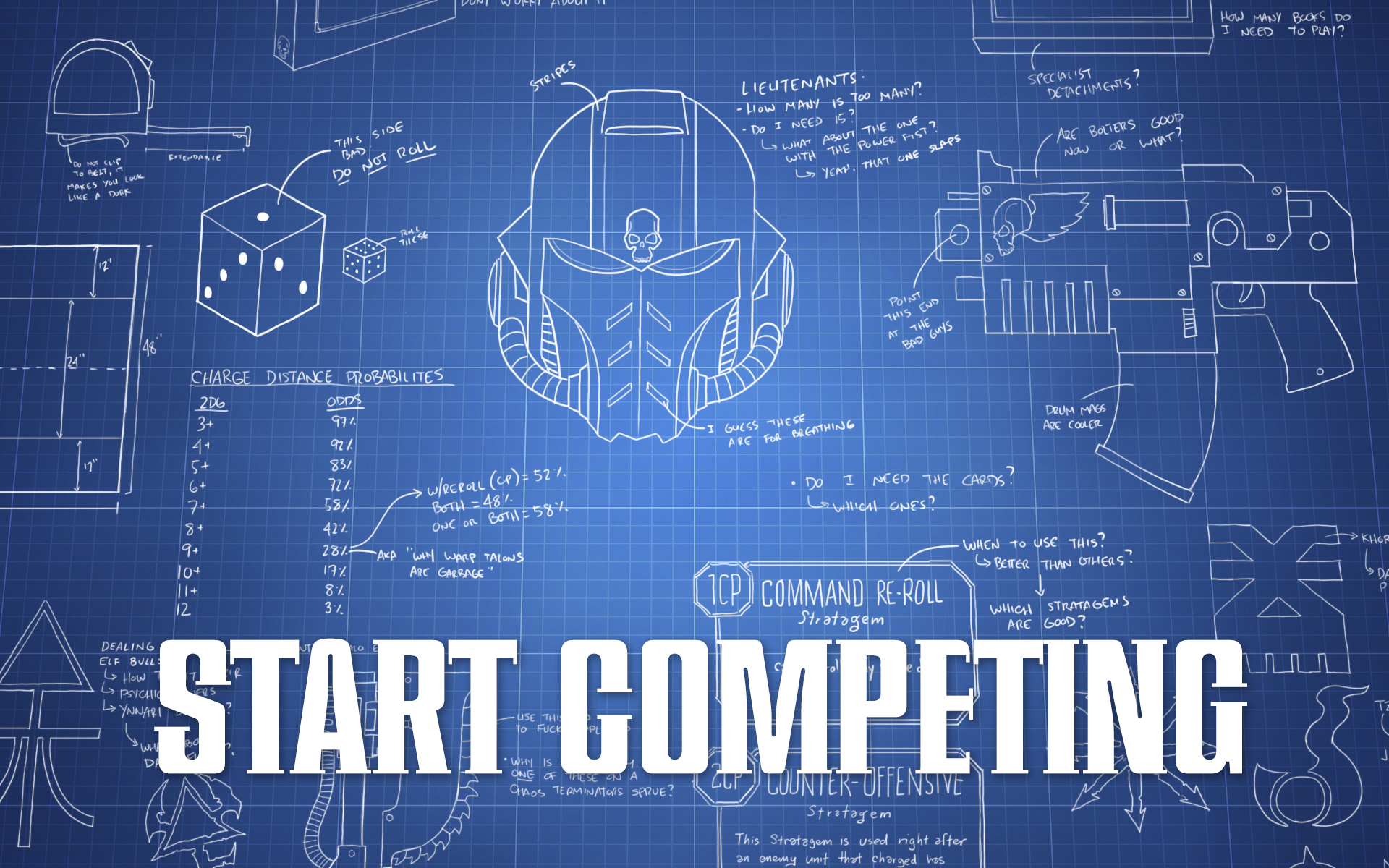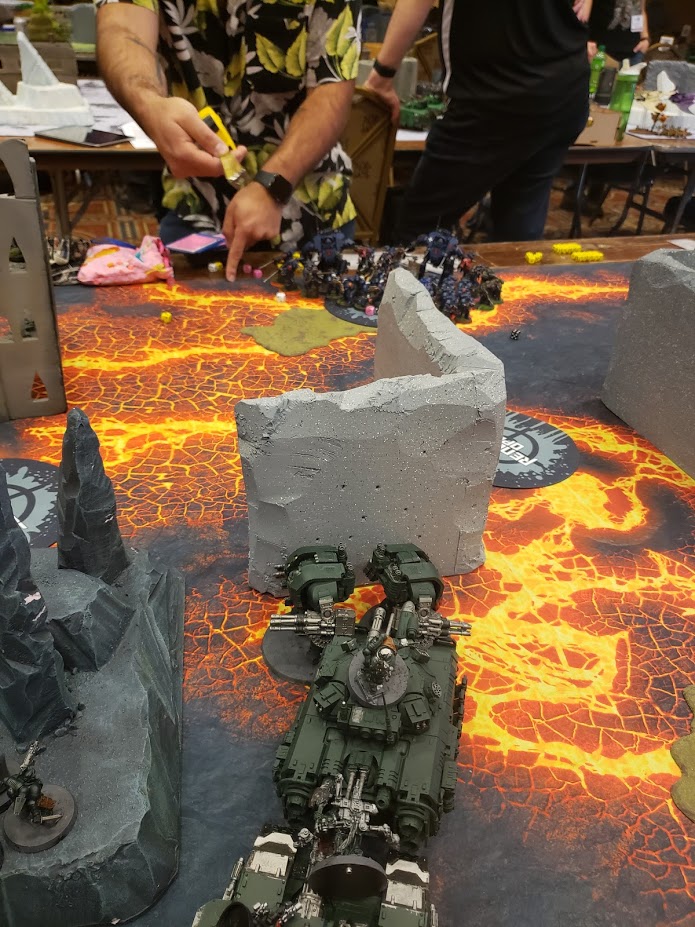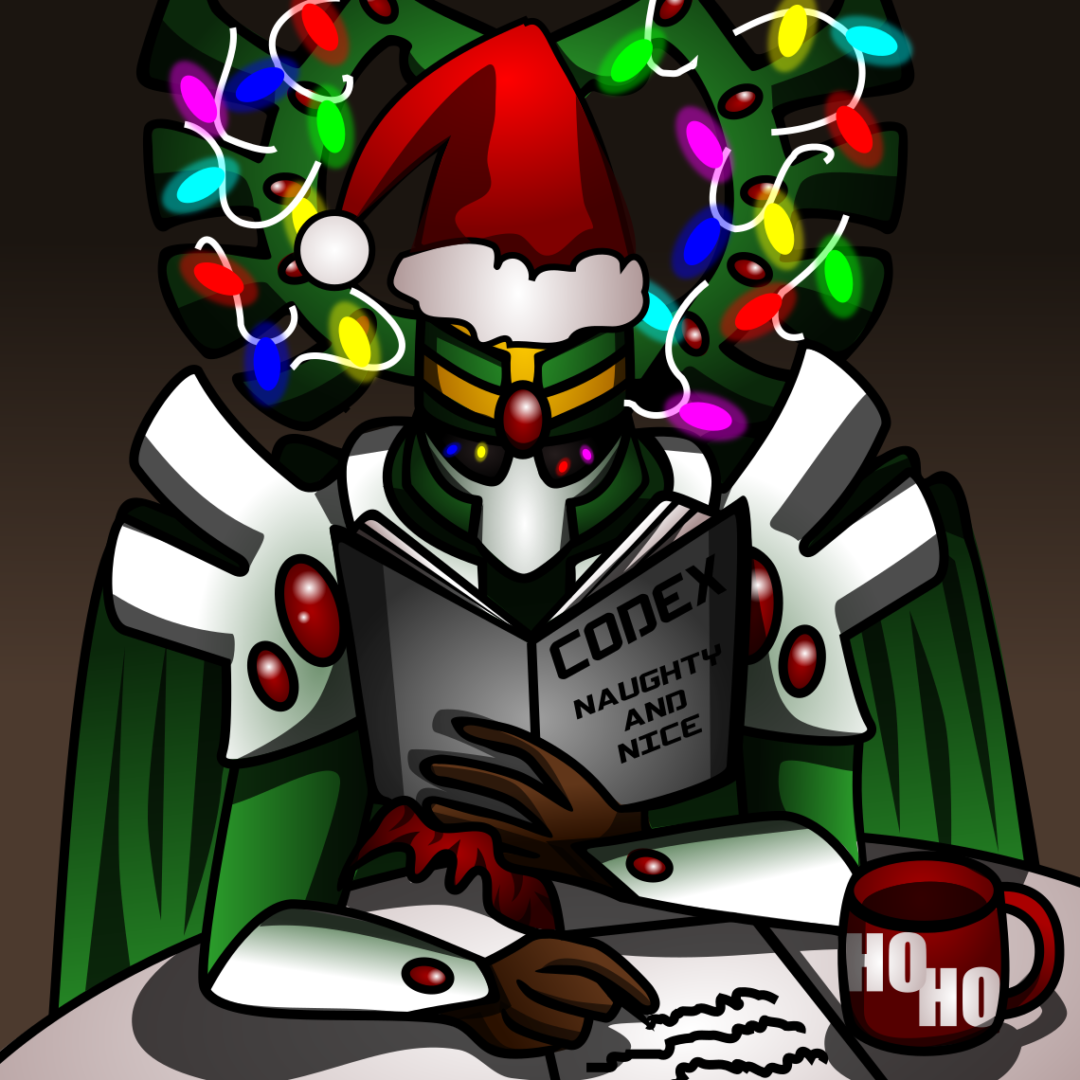Let’s start in media res: Imagine you are staring down an Iron Hands gunline. You have the bottom of the turn and have eaten some real damage without punching back as hard as you could have. Maybe your target priority wasn’t great, maybe the deployment map was bad, maybe your dice just went cold. Your opponent has both of their Executioners still up, and they correctly prioritized killing all your anti-tank units. You know there is no way you can kill the Executioners. You know if the game is played out to its conclusion you will be boarded. Do you throw in the towel? If you said “yes,” I don’t blame you — I certainly have. However I have also seen 27-26 wins or 25-25 ties pulled out with only a handful of models left on the table, piloted by players who held on to the bitter end. Back in the Before Times I would have literally 2 Tactical Marines left out of my Battle Company allowing me to hold on for a win – the points were what they were and I had more.
Let’s talk about how that happens.
Note that, as I play almost exclusively ITC format games, this analysis will primarily be through that lens, but many of these concepts and lessons will be applicable to other formats.
Playing From Behind
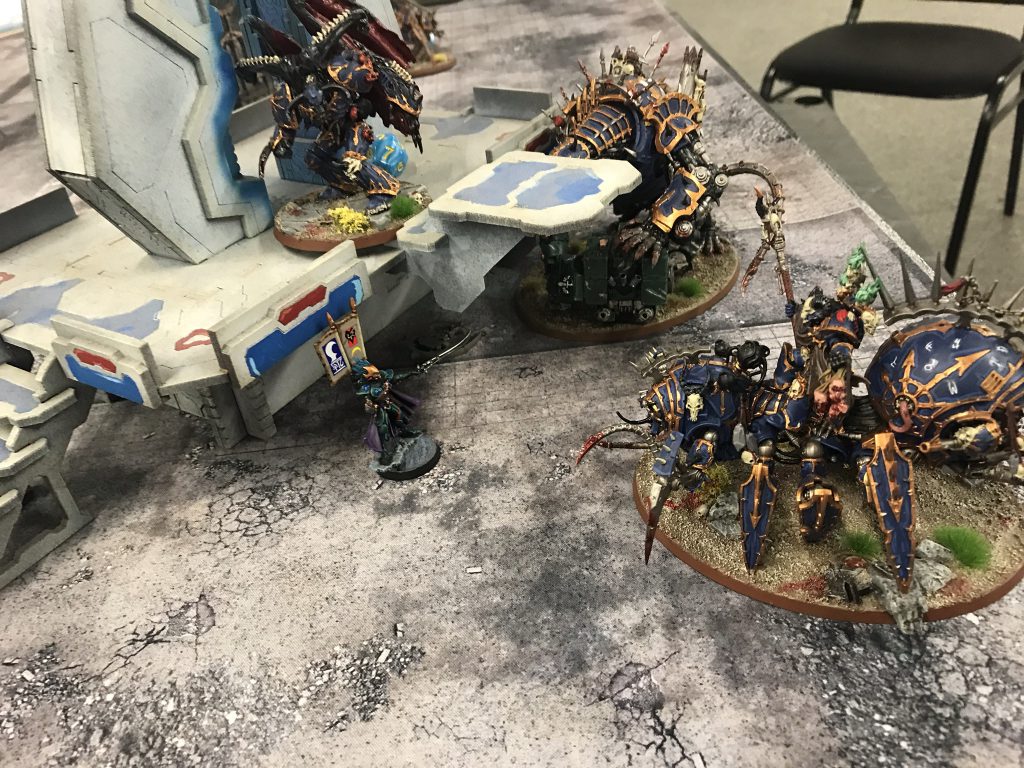
Let’s start with the worst-case scenarios: The games where things have gone terribly wrong, the tables have turned, or things just aren’t panning out. In this section I’m going to talk about strategies for turning a losing proposition into a winning one, and digging yourself out of some deep holes.
Setting Up for Success
To be able to play from behind and maybe “Get There” you have to have set yourself up with your pregame decisions. In ITC formats, making realistic secondary choices for your army is critical to being able to pull out a win or draw in a game that “should” be a loss. Try to avoid the “Win More” choices of Ground Control, Old School, and Butcher’s Bill (with Headhunter/Big Game). Focus on having a game plan that the other player cannot disrupt. The Engineers secondary objective, for example, can be a solid choice depending on map and terrain. Take special note of Objective markers that may not be in your deployment zone, but have great LOS blocking to protect the units holding them. Recon is also a solid pick for a secondary if you have the mobility and depth of roster to throw away 1-2 units a turn in the latter turns.
Choosing Not to Seize
Choosing to go second — even against some awful gunline — is sometimes the correct play. Is it scary? Oh yes. Will you lose materiel? Most certainly. But doing it allows you to have the bottom of the turn. And the bottom of the turn is the answer turn. Going first is asking a question: Can you recover from what I am doing? However the answer, if the other player has anticipated and set up correctly, can usually be: Yes. Yes I can. Practically, this means during deployment you assume you will go second and deploy your forces accordingly. Everything out of line-of-sight, only exposing durable units (We’ve talked about deployment in detail before). Maybe they flub their shooting, maybe you get some nice invulnerable saves. But what you can do here is force movement. Forcing your opponent’s castle to shift a bit to try to get sight lines might bring key units into position for you to catch with your counter chargers, or allow you to keep most of your army behind a wall while you shoot at the unit that peeked out.
Practically speaking that also gives you the chance to know how many units your opponent has killed so you can adjust your targets to force a push on kill more. Or to know that your opponent picked up 5 chaff units and that you can just focus on killing something big. It also gives you an answer on objectives. Can you run some troops out to obsec steal an objective or shoot some fragile troops off some far flung position? This also gives you the final answer in a couple positioning objectives. Having the final moves for Ground Control or answering Linebreaker units can be huge.
Preparing Your Positions
Going hand-in-hand with going second. Good ol’, finally-printed-for-real-in-Chapter Approved, indispensable Prepared Positions. Should you use it? Yeah. Probably. It depends on the opponent’s guns and your units, but a common thing I find is giving myself a 6+ against AP -4 lascannons can be the most frustrating thing in the world for opponents relying on them to connect. It can force them to really focus fire to accomplish something and may even deny them a kill altogether. Either way what you are trying to do is mitigate the damage taken on that first turn to better recover, and even in Ad Mech when I can just choose to have a cover save with Shroudpsalm I’ll still use Prepared Positions to save Shroudpsalm for turn two. Does all this mean you have to have CP for this? Yup! But if you’re building armies well and planning on having lots of units with Objective Secured, this won’t be as big an issue thanks to your double battalions or brigade. Sorry, bad/expensive troop havers.
Secure that Object
Objective Secured — or the many names referring to the same rule in 8th edition that allow a player to control an objective regardless of how many models they have if a specific unit is within 3″ of it — is a powerful rule, and one that wins games. Be mindful of when you can use it to your advantage to prevent your opponent from scoring, or force them to wipe a unit off an objective completely.
Think Skinny
We love the NOVA L here at Goonhammer. These terrain features provide tall line of sight blockers in the middle of the table and give play to all sorts of armies and strategies that aren’t “Gunline supremacy on Planet Bowling Ball”. As a general rule you should use these and other terrain features like them as much as possible. unless a model is going to be scoring mission points or providing decisive firepower that turn it should be hidden, waiting. We live in a mostly true line of sight world. All models can shoot and be shot from every point. Generally, you need to think skinny. Be mindful of guns, antennas, points of the nose of jetbikes, wings, whatever. Ask your opponent to help you out to try to hide models. “Can you see this? rotate model how about now?” This is important because sometimes things go sour and now these waiting models are now going to be the pieces that win the game. These are the bolter Scouts who are going to run out and grab a Recon point or the three man Infantry Squad getting MOVE! MOVE! MOVE!’d out to an objective.
Driving the Four-Point Turn
I’m super guilty of not really paying attention to the exact score during my games. Do I care it’s 7-5 on the bottom of 1? Not even a little. In close games I also expect most people to score all 12 secondary points against me unless they chose to lose the Secondaries Mini Game. Instead when I look a the score card what I pay attention to is the differential each round:
Round 1: 4-2
Round 2: 4-2
Round 3: 3-3
Round 4: 3-4
(someone got the bonus!)
That’s a tight game. But it looks like player two might be on the upswing.
Round 5: 2-3
Round 6: 1-4
RIP player 1. Final Score: 17-18, assuming secondaries are maxed out, 29-30. Close though, right? You can see the tilting point in the score of who is controlling the game. Player one crushed the opening. Kill and Hold more for two turns in a row. Pretty disheartening. But watch. See that 3-4 though? You know what happened there? Kill Something. Hold Something, Hold More, Bonus. 4 point turn. Player two in this scenario may have never got kill more until the very end.
Players get very focused on the Secondaries but neglect what is happening in the primary. The person who gets to dictate the primary is the player going second. The one who is answering the “Can you recover from this” question being asked over and over. So pay attention to the primary. Don’t walk off of objectives or commit to objectives unless you know you can get hold more. Watch how your opponent is holding objectives. Are things double covered with two tanks that are realistically not going to be destroyed? Or is it a squad of Dire Avengers trying their best to not be noticed they can be shot off for a Kill and denying your opponent a hold more point?
Finally, pay attention to the bonus objective. Great players will focus on grabbing the bonus ASAP. Start thinking at deployment how you are going to get the bonus. Line up troops to grab objectives, fast moving units to run out and contest those far flung objectives, and make sure to not lose at list building and have enough characters to be able to compete on the “Contest 3 with Characters” mission. Throwing away troops for the bonus will usually cost you kill more, but if you are setting up for a turn where you aren’t going to get kill more anyway, go and grab that bonus and make it a wash in points for your opponent.
Commitment is Hard
Commitment is hard. And that’s why we are all in therapy. Or at least why we’re pointlessly losing units and games. A lot of what I’ve talked about above is really knowing when to commit your units and when to be patient. We all want to squeeze ~Maximum Value~ out of all of our precious shooting and melee resources. Raise your hand (don’t do this, I’m not actually talking to you) if you have pointlessly thrown away a smash Captain because you were too eager to go… well, smash with the Captain. Conversely, how many games have been lost because you came out of cover a turn too late? Or the most common mistake: Coming out piecemeal. Float out a couple tanks that can’t quite reach optimal targets, walk a unit or two of infantry out, or come in from deep strike when most of your opponent’s army (and therefore most of their incidental shooting) is still up and everything dies. Now you’ve lost a key portion of your army with little to show for it.
I am reminded of a specific game from earlier this year when I was against a pretty tough Imperial Guard/Imperial Knights gunline while playing my Dark Angel character Speeders/Guard/Knight list. I had about 50 infantry in a center LOS-blocking building and had 15 Rough Riders (RIP you Legendary horse peoples) and 10 infantry coming in. On turns one and two, my Guardsmen could have come out and shot some lasguns at his Guard and been murdered for their troubles. So instead I waited until I had to commit my reserves to entering the table on turn three. When they arrived, I pushed forward with my Guardsmen, and the effect was target overload for my opponent. The 15 Rough Riders and infantry sweep up on the flanks, while all the rest of my idiots push into the building into the middle of the table and let’s start shooting. Did I lose a bunch of models? Sure did. Did I still have the assets left over on 4 to charge mortars and grab objectives? Yep. Because while there is a lot of shooting in the game that can slaughter Guardsmen, most of it can’t kill 60 wounds’ worth in a round, especially if the opponent’s army is depleted from my shooting AND need to continue to use their big and medium guns against my other threats.
Know when to commit and when you do, actually go for it. Anything less and you will be picked apart.
Know When You’re David…
All that said, when you’re the underdog — when you’re behind, when you’re in a bad situation — high-risk, high-reward moves are your friend. Big bets that can pay off big and turn things around are exactly the kinds of strategies you need more of the more your chances of winning have diminished. That doesn’t mean taking stupid risks, or throwing away units, but it does mean that you can try to leverage some tactics that aren’t nearly as certain, or that leave you without a backup (and remember, the goal here is high-risk, high-reward. Don’t forget that your risky strategy needs to have a big payoff to be worth considering). Note that these will fail more often than they succeed by their very nature, but if you’re already losing, playing it safe is much less likely to get you ahead, especially if your opponent is doing the same.
Calm and Focus
Actually putting all of this into action is going to require that you keep a cool head when the chips are down. And that can be really difficult, especially when things go very bad very quickly. When everything is going to hell and a loss seems inevitable, take a step back. Breathe. Think about what moves you have left. The fewer units you have, the fewer your options will be, and while that’s not great, it can also help simplify things. Going back to the four-point turn section above, think about what primaries you can score, what secondaries you can achieve, and how you can achieve them over your remaining turns. Focus on scoring as many points as possible and keeping units on the table. But you can’t engineer a surprise victory or valiant loss if you’re so caught up in angst that you can’t make good decisions.
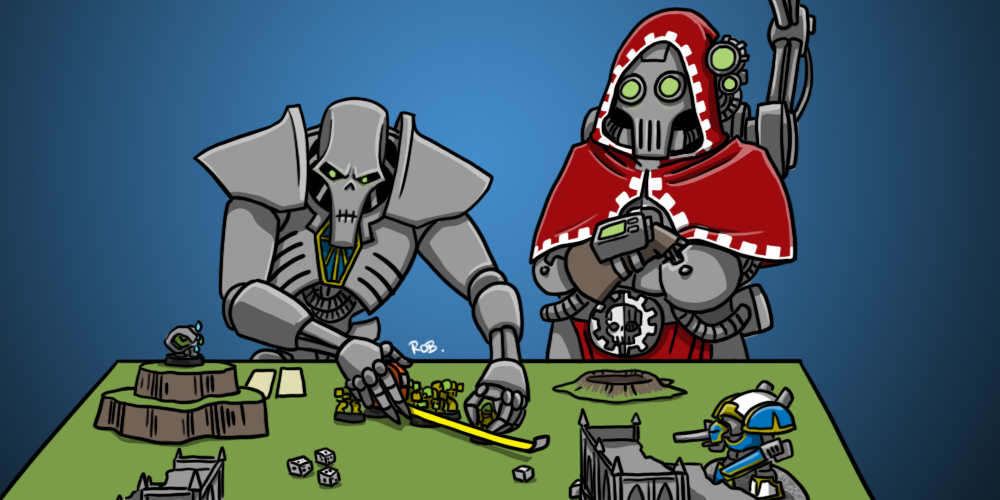
Hanging On When You Are Ahead
Playing to Win
If you want to win, you have to play to win. Are you setting up against someone for whom it’s their first event? Is it clear your opponent is here for the hobby track? Is your opponent clearly having a bad event and just wants things to be over? Don’t go soft on them. Don’t let your good person tendencies affect what you do in the game. Score the points, kill their models, stand on objectives and just be over with the game as soon as possible. Note that this does not mean that you should be a dick; be helpful and kind, be personable, give them the appropriate level of help and reminders, and never lie or cheat about what your army does. But don’t pull your punches. Respect them by playing like you are trying to win. Because toying with a soft opponent is truly poor sportsmanship. It’s hard to make “mistakes” that aren’t patronizing, so don’t. Your opponent will appreciate being taken seriously.
“That’s Great Kid, Don’t Get Cocky!”
Ah hubris, that greatest of flaws. Pride, that greatest of sins. Looking at a list and losing on turn minus-1: List Pairings. “I should be able to handle this. I’ve never lost to <INSERT ARMY HERE>.” It’s the opposite of the stage fright that comes from being paired against the local (or international) star player. It’s being sloppy or cute in deployment because it’s so improbable to lose this match up that “I can sit back and have a beer or three while I push around toy soldiers.” But all of a sudden it’s now turn 4 and I’m realizing that I’m gonna lose this game and as the kids say “I played myself.” Maybe I still pull it out with a clutch Advance roll to grab Hold More or his dice go cold and he fails to get a kill, stealing a clutch Kill/Kill More that would have given him the win.
Respect every opponent. Treat every opponent like they are an equal and set up and strategize correctly. Don’t be sloppy and just put models down kind of in your “default formation.” When playing, make sure to be mindful to get that Kill More and Hold More, even when you are ahead. Deny secondaries. They pick Engineers? Turn one, kill the Engineers. They pick Marked for Death on a unit? Keep that unit behind LOS and out of harm’s way. Even when you are crushing on the score board and getting your four- or five-point turns, don’t get sloppy. Play conservatively and be appropriately risk-averse because you never want to give you opponent a way back into the game.
…and When You’re Goliath
If you’re ahead, or massively favored because of whatever match up, variance and high-risk strategies are your enemies. You want to play conservatively, avoid risk, and as above, don’t give your opponents an opportunity to get back into the game. As the overdog, risky strategies can lose you the game if they fail and if they succeed, they usually just result in you winning by more, which isn’t your goal – you just need to win.
The Boot on the Neck of Fun
I say it a lot on the Discord and on old, dead, forums: if the game came down to a couple dice rolls, you should have lost that game. At the very least, it means you won because you got lucky.
What I mean is that there were probably a few decisions, including in the pregame, that were made that snowballed into a bad position. The secondaries that were picked were a mistake, LOS wasn’t checked and that hill isn’t quite tall enough to hide those troops, ranges were eyeballed and it turns out you left something at 44″ instead of 45″, you chose to go second and really needed to go first or maybe you seized when you shouldn’t have. Maybe in game decisions is what got you: some troops got thrown away, maybe something was pointlessly exposed to some range bands that could have been avoided OR the other way: Units were committed a turn too late, a bunch of your shooting was back-lined and was a little short for a round or put behind LOS-blocking terrain and couldn’t get proper firing lines. The thrill of a game hinging on a successful Feel No Pain roll is a roller coaster of emotion but make sure to think back on these games and see if you can see some sloppy play. Ideally all our games are recorded and you can watch the tape, but even visualizing each turn or writing out a battle report can help provide a structure that reveals “man I really didn’t need to get out of my rides” or something similar.
Ideally, for every game you win or lose, the outcome is a direct result of your decisions. So that when you win, it’s because you played perfectly, and when you lose, it’s because of your mistakes. Don’t blame dice, or the terrain, or the mission. The top players in this game don’t change. Is it because they army hop? Are they always chasing the meta? Or are they actually good and understand this game and learn from their mistakes? Sure, failing every charge, having poor damage rolls, making all your saves, these events all happen. But not every game. 40k is built around probability and risk management. It’s why 9″ charges out of deep strike are never a great plan. It’s why you want to have flat three damage weapons over D6 damage, and the autocannon is consistently one of the better weapons in every edition. Good players build redundant lists full of useful units, set up shooting with secondary targets in case variance happens, and generally try not to let their game depend on a few critical dice rolls, because it’s too risky if things go wrong.
The Wettest of Blankets
Conventions are fun, and sometimes they are in fun places. You’ll run into people who you know and love and want to hang out with until the early hours. And with that comes beer, bar food, long days, and short nights. And the hangovers. Oh man, the hangovers. Playing 40k hungover is a rite of passage for any travelling 40k player and I’m certainly re-learning my lesson every single event. However. If you have a winning record, try to avoid getting blitzed between rounds. Sure you crush an opponent, buy a round and have a chat while you are waiting on the now very long break. But keep it to a single drink. You gotta keep your head clear for rounds 2 and 3. And that whole next day. 40k events are not sprints. You have to stand and think real hard for 3 hours at a time, 6 or more times over a weekend and that requires endurance. Don’t go nuts in the evenings. Have a couple drinks and get some sleep. Finally, eat a damn vegetable. It’s very easy to not eat anything green for days on end when it’s convention time and then feel like trash afterwards. I know I feel a lot better on day two if I am mindful of my meals and go for salads and whatnot when given the choice.
Note for Nick Nanavati: If you are Nick Nanavati, feel free to ignore this and keep pounding Miller Lites every turn. But then, you are already Nick Nanvati, and you don’t need my advice on how to play 40k.
What’s The Count?
Wings here, briefly taking the wheel.
A final tip I’d like to share, coming back to the point about scoring differential earlier, is that whether you think you’re ahead or behind if the game looks even slightly close you should be stopping, adding everything up, and making sure you know what the score is going into the last few turns. I would recommend doing this at the start of the last turn you are taking before your opponent’s last one (so your turn 5 if you went second, turn 6 if you went first).
Are all your opponent’s secondaries maxed and you’re still 6+ points ahead? Great, you can relax and just aim for max points. In any other situation, there’s still a game to play for.
If you’re ahead, working out what would need to happen for your opponent to pip you to the post lets you plan accordingly, and look for opportunities to shut them out of any chance of doing that (which is why we’re doing this before their last turn). If they need to kill two more tanks and their only remaining heavy weapons are attached to something you can bully charge, get on in there, even if sacrificing whatever you’re charging with wouldn’t have made sense earlier on. Perhaps they’d need absurdly lucky shooting to take you off the board for a four point turn 6, but they could just pull it off with appropriate sacrifices to the dice gods – so move one of your characters behind a wall miles from anything. ITC often produces fairly close games when evenly matched forces play, and the scoring doesn’t always reflect how the game “feels” on the board. Making sure you actually pause and count means you won’t overestimate your lead and throw the game because of it.
The opposite is true if you’re behind at this point. Counting up the points gives you a clear, definable goal for what victory means, and lets you assess what possible routes you have to achieve it. If you’re behind there’s a good chance your options aren’t great or that likely to work, but this is where Cyle’s point about being willing to take risks when you’re behind is at it’s most important. The game is ending shortly either way, so you’ve got nothing to lose by going for broke. You should work out the score you need for a win, work out what possible chains of actions get you that many points, identify the most likely one to work and then start playing it through as if it’s going to. Plenty of times you’ll fall at the first hurdle (say step one was “I need to shoot my lascannon at that tank for at least 5 damage” and you roll a 4) and it’ll feel like you maybe should have taken a safer line, but if the safe line was only ever taking you to a narrow loss then it wasn’t the right play, even if the high roll plan didn’t work out.
This Game is Actually Not Bullshit
Even in these dark Iron Hands times the game isn’t actually bullshit. It wasn’t bullshit when the Ynnari Circus was in town, or during the long Castellan summer. Broken and overpowered things come and go. Games Workshop misses the ball for a number of reasons, but chief among them is that the playtesting community isn’t tens of thousands of players deep and things have to actually go into print books with impossible lead times (Chapter Approved 2019 and its point changes likely went to the printers before June). Does it get old playing Marines 4 out of 6 games? Sure. But honestly I don’t really notice that. I’m excited to see if I can handle the bogeyman of the month. Did I bring the right tools? Because if I did, I bet those tools will work against most of the field. If your favorite army is now the monster, don’t run away because you are no longer playing the hipster army, lean in and enjoy ride. If you are getting beat when you have the broken army of the month, maybe look at what you are doing in play. You can no longer hide behind a weak faction. Finally, I understand that sometimes whole armies have been bodied out of the meta for long periods of time. However, It was a short amount of time ago that Marines were a bottom-tier army. This storm shall pass, as will the next. Keep at it.
